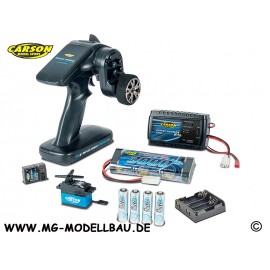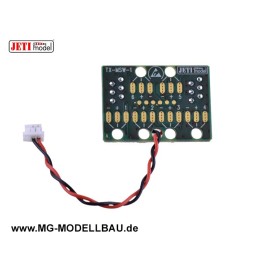FUTABA DLPH-1 Dual RX Link Power Hub
Item No.: F-01000988
EAN: 4513886034879
SAFETY FIRST! With the Futaba Dual Link Power Hub DLPH-1 you quadruple the safety in your model by operating two S.BUS/S.BUS2 receivers and two batteries in parallel. In the event of a problem with the main receiver or one of the batteries, the DLPH-1 switches to the second receiver or the second battery in a flash. But the DLPH-1 can do so much more...
The Futaba Dual Link Power Hub DLPH-1 is designed for the high current supply of Futaba S.BUS receivers and normal servos (PWM) as well as S.BUS/S.BUS2 servos. The servos are connected to the DLPH-1 at the corresponding servo outputs. These supply the servos with power and with the position and control signal. A single connection cable between the DLPH-1 and the receiver is then required for the power supply of the receiver itself and the signal transmission.
The DLPH-1 has a telemetry voltage sensor. The following voltages are displayed on the DLPH-1 via telemetry (receiver1): ACCU1 (default slot 6), ACCU2 (default slot 7), receiver voltage: 5.2V regulated (slot 0). The "SBS01V" is used for the voltage displays during sensor registration.
If several servos have to work at the same time with a lot of power and/or high speed, this generally poses a problem for the power supply of the servos, because power and speed always go hand in hand with high current requirements. This current demand cannot be sufficiently provided for the battery via the single plug-in connection directly at the receiver, so a "bottleneck" for the necessary servo current is created. When this is needed, the voltage collapses, the servos become less powerful or slower, or both. In the worst case, they even stop and the receiver fails. Depending on the current requirement. By using the Futaba Dual Link Power Hub DLPH-1, the current flows directly from the batteries via the DLPH-1 to the servos.
Principle of battery backer
Battery backers are used to provide redundant power to a system by using a second battery. This results in "battery redundancy". Two batteries are used so that in case of failure of one battery, the other battery maintains the power supply of a system. In principle, this would be easy to solve by simply connecting a second battery to the system in parallel. Unfortunately, "Ohm's law" gets in the way: current always flows from a higher voltage to a lower voltage... So from the battery with the higher voltage to the one with the lower voltage - always. Two batteries will never have the same voltage or load capacity. Thus, the current of the better battery does not flow to the system, but to the "worse or empty battery". This usually leads to the complete destruction of both batteries and to a crash of the model.
The Futaba Dual Link Power Hub DLPH-1 therefore solves the following problems:
- The servos with high current requirements are connected to the DLPH-1, no longer to the receiver.
- The DLPH-1 has two XT60 high-current connections for two receiver batteries due to the built-in battery switch. Their voltage is then fed (via the built-in battery switch) directly and without loss to the servo sockets on the DLPH-1.
- The position and control signal for the servos is routed separately from the receiver to the individual plug-in connections. In order for the receiver to work, it receives its voltage from the DLPH-1 via a single patch cable (S.BUS signal, all in parallel).
- The positioning signal is routed via the S.BUS to the DLPH-1's plug-in connections.
- The operating current for servos and receiver is thus "split".
Why high current for servos, what happens if there is an undersupply?
- For the large, dynamic, very short fluctuations in current demand (current peaks) of today's servos, an unobstructed current supply to the servos is absolutely necessary. Therefore, not only high-current batteries must be used in the functional chain, but also connectors and cables that can supply the high current to the servo sockets.
- Classical voltage controls work rather inadequately, as they are always "slower" than the fast (very dynamic) fluctuating current demand of the servos, and also slower than a high-current battery, which can certainly supply these current peaks.
- Modern servos, however, need precisely these current peaks in order to be able to deliver their actual power. Therefore, there is nothing better for the power supply of such servos than to lead the battery voltage to the servos in the most direct way, without any voltage regulation or other resistances such as unsuitable plugs or long or thin cables.
- The best way to adapt to different servo voltages is to use the appropriate battery types. LiFe batteries for all servos, or LiPo batteries for LiPo(HV) servos. This eliminates the need for voltage regulation.
Technical data:
Servo outputs: 18
S.BUS outputs/inputs: 2
Battery connection: 2x XT60
Suitable batteries: LiFe 2s, LiPo 2s, LiPo 3s (NOT for FUTABA servos from the hobby sector!)
Continuous current max: 60A
Voltage range: 6.4-13.0V
Input voltage = output voltage
Dimensions: 62,8×62,4×18,1mm
Weight: 50g
Features:
High current supply for receiver and servos
Integrated receiver & battery switch
2x S.BUS receiver connector
2x XT60 high current connector
18 servo outputs + 2x S.BUS outputs
Scope of delivery:
DLPH-1 Futaba Dual Link Power Hub
Switch cable
2x patch cables for receiver
Mini screwdriver
Mounting material
Manual
Already seen?
EUR 119,99
incl. 19% MwSt
EUR 34,95
incl. 19% MwSt
EUR 36,90
incl. 19% MwSt




